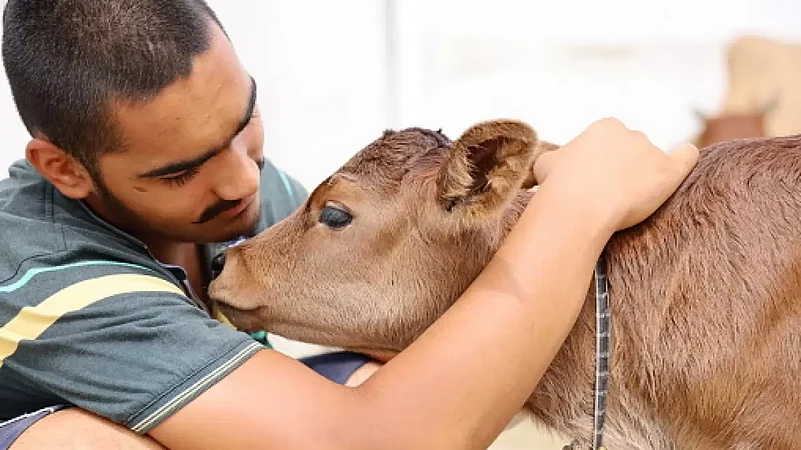Cuddling or hugging a cow can bring us closer to the nature and the embrace makes us feel like we are in our mother’s lap, says SP Gupta, former Chairman of the Animal Welfare Board of India (AWBI).
Gupta, a retired IAS officer, is the founder of Kamdhenu Gowdham and Arogya Sansthan, a non-governmental organisation (NGO) working with cows in Haryana. He has floated the concept of cow-cuddling therapy —gau sparsh chikitsa— in a Cow Cuddling Centre launched in 2021.
In an interview with Outlook, besides the therapeutic effects of cow, Gupta also touched upon the social and economic value of cow in the Indian society.
What is the concept of cow-cuddling or gau sparsh chikitsa? Does it actually work?
Most of the problems of the modern life are rooted in disharmony with nature. Our body parameters such as heartbeat, blood pressure, and breaths are out of sync because of the stress we carry most of the time. Cuddling or hugging a cow brings us close to the nature. The warmer body temperature of cow and slow and steady breath make us feel like we are in the lap of our mother. Spending some time in such comfort has considerable healing effect. Cow cuddling is emerging as a new wellness trend in the West but in India it has been part of the daily life since time immemorial.
What motivated you to promote this concept?
Cow has been central to the Indian culture. It once formed the backbone of Indian economy and symbolised prosperity and wealth. For the innumerable benefits it provides to humans, cow has been accorded the status of mother. Revering cow is ingrained in people. So the deep respect and love for cow has been by birth and natural for me. I strongly believe that cow could play great role in revving up India's rural economy. Maintaining indigenous cow costs virtually nothing. It gives us much more than what it takes from us.
Economic benefits apart, staying in the proximity of cow aids your mental well-being. Many people are not so much healthy mentally these days. They face many psychological issues which manifest in lifestyle problems. A large section of society seems to be grappling mental issues. Cow-cuddling being a therapy could help them in a big way. A good mental health expands a person's possibility of being successful in life. This underlying belief motivates us to promote and popularise the concept of cow-cuddling.
You claim that cow cuddling cures diseases such as heart problem, spinal pain, respiratory diseases, depression, and even tuberculosis, and reduces tension and anxiety. Is this based on any scientific evidence?
It has been found that cow-cuddling brings positivity and boosts secretion of oxytocin (the hormone released during social bonding) in the body. Psychologists have confirmed the numerous benefits of touching and interacting with pets. In times to come, more scientific evidence would emerge to show the benefits of cow-cuddling. As explained earlier, cow-cuddling brings harmony with nature and therefore works at the root level of many lifestyle diseases.
You have a concept called Cowmunication. Could you explain what does it entail?
Cow-Munication or 'communication with mother cow' is actually the feeling that one gets in the lap of his/her mother. Just as one feels that his worries have disappeared when in company of mother, cow-cuddling brings the same sense of comfort. The warmth is magical while hugging or cuddling a cow. This communication is not apparent to a third person but it is very powerful.
Could you tell us a bit about your career and trajectory. What inspired you to run an institute for cow welfare?
I have been from civil services background and I retired from Indian Administrative Service (IAS) of Haryana cadre. During the service, God was kind enough to give me opportunities to work for cow welfare. The Kamdhenu Gowdham and Arogya Sansthan is the culmination of our decades of efforts. It is just not a cow-welfare project, but human welfare initiative.
You were the chairman of the Animal Welfare Board of India (AWBI). Did you take similar such steps while serving in the post?
Irrespective of my official positions in the past, I served the Mother Cow and continue to dedicate my time for the cause of cow welfare. Post-retirement, now that I have more time, my daily life revolves around cow welfare. Kamdhenu Gowdham and Arogya Sansthan organises talks and discourses on the significance of cow every month.
As AWBI chairman, I travelled throughout the country and actually became more familiar with the modern concept of animal welfare including for Indigenous (desi) cow. In our culture, there are certain traditions where animals are used in sports. For instance, in Tamil Nadu, Jallikattu (bull taming sport) is organised as part of Pongal celebrations. We made sure that the tradition continues but without putting animals into any stress or cruelty.
What is the flow of people to your Cow Cuddling Centre? Does it have an economic model?
Our aim is not to make money but to serve the society. Kamdhenu Gowdham and Arogya Sansthan is open for all and you will see many people coming with their families over weekends. Many of them donate to the Sansthan out of their free will and the feeling to serve the Mother Cow.
Even through the cow is a useful animal, especially for its milk and dung, many would not agree with your theory of curing diseases through cuddling the animal. They might even call it unscientific. How would you respond to them?
There are many alternative practices where there has not been enough research but they have been found to be very effective. Many people would talk about their life-changing personal experiences and benefits they derived. Yoga is also an ancient practice which emerged thousands of years back but many of its benefits are now being proven by research.
















